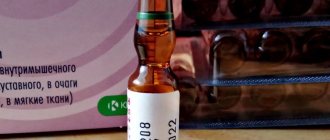Oftan-dexamethazon (Oftan-Deksametazon)
Dexamethasone
Indications for use:
Addison's disease, congenital adrenal hypoplasia, adrenal insufficiency (usually in combination with mineralocorticoids), adrenogenital syndrome, thyroiditis (acute, subacute), hypothyroidism, tumor hypercalcemia, shock (anaphylactic, post-traumatic, postoperative, cardiogenic, blood transfusion, etc.), rheumatoid arthritis in the acute phase, acute rheumatic carditis, collagenosis (rheumatic diseases; disseminated lupus erythematosus, etc.), inflammatory and degenerative diseases of the joints (arthritis, tendovaginitis, bursitis, epicondylitis, styloiditis, osteochondrosis, osteoarthritis, ankylosing spondylitis, etc.), myositis, infectious-allergic bronchial asthma, status asthmaticus (IV, IM), allergic and anaphylactoid reactions, incl. caused by drugs, dermatitis (contact, atopic, exfoliative, blistering, herpetiformis, seborrheic, etc.), psoriasis, eczema, exudative erythema multiforme, pemphigus, mycosis fungoides, erythroderma and other skin diseases, cerebral edema (with tumors, cranial -brain injury, neurosurgical intervention, cerebral hemorrhage, encephalitis, meningitis, radiation damage to the lungs (IV, IM), ulcerative colitis, hepatitis, sarcoidosis, berylliosis, disseminated tuberculosis (only in combination with anti-tuberculosis drugs), disease Leffler and other severe respiratory diseases, anemia (autoimmune, hemolytic, congenital, hypoplastic, idiopathic, erythroblastopenia), idiopathic thrombocytopenic purpura (in adults), secondary thrombocytopenia, lymphoma (Hodgkin, non-Hodgkin), leukemia, lymphocytic leukemia (acute, chronic), agranulocytosis, plasmacytoma and other blood diseases, nephrotic syndrome, severe infectious diseases (with mandatory combination with antibiotics), multiple sclerosis, non-purulent and allergic eye diseases (conjunctivitis, keratitis, iritis, iridocyclitis, blepharitis, blepharoconjunctivitis, episcleritis, scleritis), inflammatory processes after eye injuries and operations, sympathetic ophthalmia, diagnosis of adrenocortical insufficiency, pituitary short stature (in children), affective disorders, incl. for depression.
Contraindications for use:
Hypersensitivity, systemic mycoses, amoebic infections, active forms of tuberculosis, infectious lesions of joints and periarticular soft tissues, the period before and after preventive vaccinations (especially antiviral ones), obesity of III-IV degree (inside); eye drops - viral, including lichen simplex, chickenpox, fungal and tuberculous eye infections, acute purulent eye infection (in the absence of antibacterial therapy), diseases of the cornea with epithelial defects, trachoma, glaucoma.
Restrictions on use:
Peptic ulcers of the gastrointestinal tract, gastric and duodenal ulcers, esophagitis, gastritis, intestinal anastomosis (in the immediate history), congestive heart failure, arterial hypertension, thrombosis, diabetes mellitus, osteoporosis, Itsenko-Cushing's disease, acute renal and/or hepatic failure, psychosis, convulsive conditions, myasthenia gravis, open-angle glaucoma (oral, parenteral), AIDS, pregnancy, breastfeeding.
Side effects:
Sodium and water retention, loss of potassium and calcium, edema, erosive and ulcerative lesions of the gastrointestinal tract (with exacerbation of peptic ulcer up to perforation, bleeding), hemorrhagic pancreatitis, atony of the gastrointestinal tract, increased appetite, nausea and vomiting, hepatomegaly, muscle weakness , myopathy, osteoporosis, pathological fractures, tendon ruptures, arrhythmia, bradycardia, increased blood pressure, congestive heart failure, myocardial infarction and dystrophy, Itsenko-Cushing syndrome, hyperglycemia, hyperlipoproteinemia, negative nitrogen balance, dysmenorrhea, growth retardation in children, hirsutism, decreased immunity, suppression of regenerative and reparative processes, dizziness, headaches, mood disorders, psychosis, increased intracranial pressure, convulsions, thinning and vulnerability of the skin, petechiae, ecchymoses, stretch marks, erythema and changes in facial pigmentation, increased sweating, increased intraocular pressure, exophthalmos, thrombosis and thromboembolism, withdrawal syndrome (malaise, pain: headaches, in the abdomen, joints and muscles), depression, secondary adrenal insufficiency; rarely - allergic reactions (rash, itching).
Interaction with other drugs : Reduce the therapeutic and toxic effects of barbiturates, phenytoin, rifampicin (accelerate metabolism), somatotropin, antacids (reduce absorption), increase - estrogen-containing oral contraceptives, the risk of arrhythmias and hypokalemia - cardiac glycosides and diuretics, the likelihood of edema and arterial hypertension - sodium-containing drugs or supplements, severe hypokalemia, heart failure and osteoporosis - amphotericin B and carbonic anhydrase inhibitors, risk of erosive and ulcerative lesions and bleeding from the gastrointestinal tract - NSAIDs. When used simultaneously with live antiviral vaccines and against the background of other types of immunizations, it increases the risk of viral activation and the development of infections. Weakens the hypoglycemic activity of insulin and oral antidiabetic agents, the anticoagulant activity of coumarins, the diuretic activity of diuretics, and the immunotropic activity of vaccinations (suppresses antibody formation). Worsens the tolerance of cardiac glycosides (causes potassium deficiency), reduces the concentration of salicylates and praziquantel in the blood.
Overdose:
Treatment: with the development of adverse events - symptomatic, Itsenko-Cushing syndrome - administration of aminoglutethimide.
Method of administration and dosage: Orally, parenterally, locally. The dose is set individually, depending on the disease and condition of the patient. Orally (during or after meals) once, in the morning (small dose) or in 2-3 doses (large dose): 2-3 mg to 4-6 mg (10-15 mg) per day, after achieving the effect, the dose is gradually reduced to maintenance - 0.5-1 mg, (2-4.5 mg or more) per day; treatment is stopped gradually (at the end, several injections of corticotropin are prescribed. Children - 0.25-25 mg, or 0.0833-0.3333 mg/kg or 0.0025-0.0001 mg/m2 per day in 3-4 doses per day depending on age.Parenteral: IV, slow stream or drip (in acute and emergency conditions) or IM 4-20 mg (up to 80 mg) 3-4 times a day, maintenance doses 0.2-9 mg per day, course 3-4 days, then - oral administration. Children - IM, 0.02776-0.16665 mg/kg every 12-24 hours. Intra-articular (into the lesion) or periarticular (into soft tissue): adults and adolescents - 0.2-6 mg (2-8 mg), repeated at intervals of 3 days to 3 weeks as needed; maximum dose for adults - 80 mg per day. For shock (adults) - IV, 20 mg once, then 3 mg/kg over 24 hours as a continuous infusion or intravenously once 2-6 mg/kg, or intravenously 40 mg every 2-6 (4-6) hours. For cerebral edema (adults) - 10 mg IV, then 4 mg every 6 hours IM until symptoms disappear; the dose is reduced after 2-4 days and gradually - over 5-7 days - treatment is stopped. For adrenal insufficiency (children) - IM 0.0233 mg/kg (0.67 mg/m2) per day in 3 injections every third day, or daily 0.00776-0.01165 mg/kg (0.233 -0.335 mg/m2) per day. Conjunctivally: for acute conditions - 1-2 drops every 1-2 hours, then - after 4-6 hours; in other cases - 1-2 drops 3-4 times a day; course - from 1-2 days to several weeks.
Precautions: Use with caution for nonspecific ulcerative colitis, intestinal diverticulitis, hypoalbuminemia. Prescription in case of intercurrent infections, tuberculosis, septic conditions requires preliminary and subsequent simultaneous antibacterial therapy. It is necessary to take into account the increased effect in hypothyroidism and cirrhosis of the liver, aggravation of psychotic symptoms and emotional lability at their high initial level, masking of some symptoms of infections, the likelihood of relative adrenal insufficiency persisting for several months (up to a year) after discontinuation of dexamethasone (especially in the case of long-term use) . Breastfeeding is stopped for the period of treatment. During a long course, the dynamics of growth and development of children are carefully monitored, an ophthalmological examination is systematically carried out, and the condition of the hypothalamic-pituitary-adrenal system and blood glucose levels are monitored. Stop therapy only gradually. It is recommended to be careful when performing any kind of surgery, the occurrence of infectious diseases, injuries, avoid immunization, and avoid drinking alcohol. In children, in order to avoid overdose, the dose is calculated based on the body surface area. In case of contact with patients with measles, chickenpox and other infections, appropriate preventive therapy is prescribed.
OFTAN DEXAMETHASONE (drops)
I received recommendations on how to behave so as not to harm him and a list of eye drops:
1. Levofloxacin 0.5% - 4 times a day, 1-2 drops, for two weeks. 2. Bromfenac 0.09% - 1-2 drops once a day, for four weeks. 3. Dexamethasone 0.1% - 4 times a day, 1-2 drops, for four weeks.
I want to talk about the latter in more detail. Usually, I take medications over the Internet, or using information from the Internet, but this time I went straight from the room to the pharmacy at the hospital. I didn’t want to “wander around” with a red eye and a post-operative bruise even on the Internet. Showed the pharmacist the discharge summary with the name of the prescribed drops and item “”3. Dexamethasone...” received “Santen eye drops”Oftan Dexamethasone”.
To my question about the quality of this drug, she replied that it is “the best of the Dexamethasone group.” Made in Finland. “”In your case, it is responsible for protecting the eye from inflammation and allergic reactions. It must be stored in the refrigerator at a temperature of 2-8 degrees Celsius, i.e. in the refrigerator, but not in the freezer. It is necessary. I’ll write “cold” directly on the box,” the woman pharmacist continued. ""But! Before dripping, do not heat it for a long time. Just hold it in your hands - tightly grasping the bottle. Warm it up a little with your palms, drop it in and return it to the refrigerator. Then you will maintain the effectiveness of the active substance."
This information was quite enough for me. Thanked. I paid 220 rubles for the bottle and went home, fortunately I live nearby.
It started dripping immediately. Here is a bottle - the dropper is not pierced - the hole has already been formed. You unscrew the cap and immediately drip the first time without any preparatory operations. Even if, on the advice of the pharmacist, you warm the bottle with your palms, they will still be cool and you will feel it. But I didn’t notice anything bad about it. Well, cold and cold.
Once the bottle is opened, it can be used for a month. This is a standard requirement for almost all eye drops. When using, do not touch the eye with the dropper, as well as with your hands. These are basic sanitation standards and must be strictly observed in relation to the eyes.
The effectiveness of the drug is evidenced by the fact that all inflammation that arose immediately after the operation disappeared quite quickly. The redness of the eye has gone. The “mote in the eye” effect no longer occurred. But, I think, in my case, these drops, apparently, are necessary not for any kind of treatment, but specifically for prevention.
You can learn more about indications for use, contraindications and other issues from the attached instructions.
With this, let me take my leave. Do not be ill. All the best. Goodbye.



